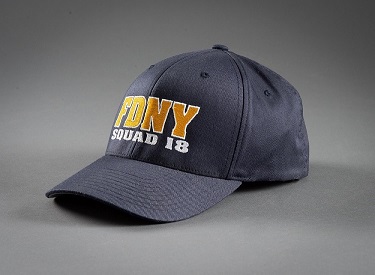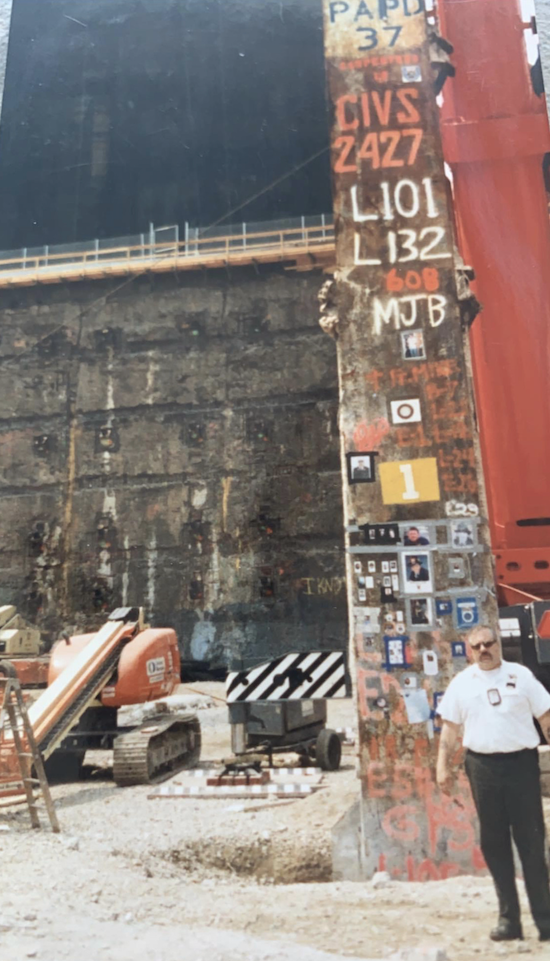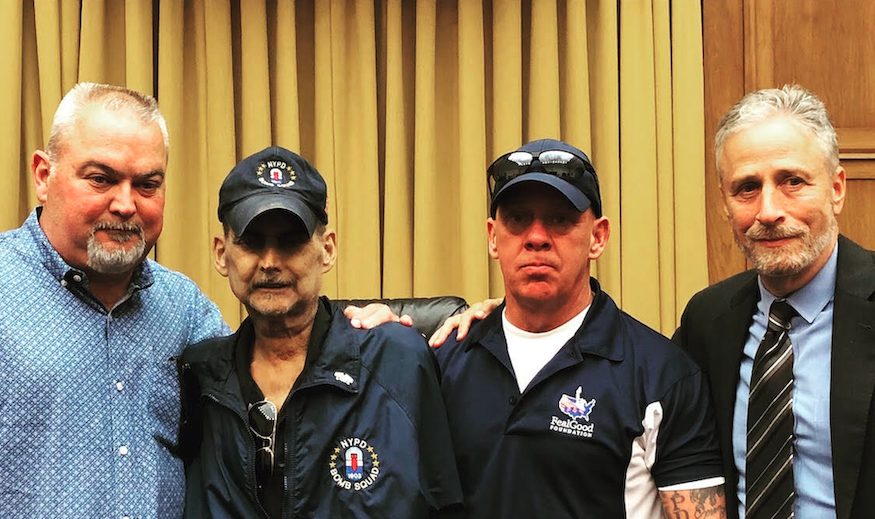Rescue & Recovery at 20: Rob Serra, FDNY
Rescue & Recovery at 20: Rob Serra, FDNY
- May 24, 2022

FDNY baseball cap belonging to firefighter Rob Serra
In this last full week of May - leading up to Monday's ceremony commemorating the 20th anniversary of the formal end to rescue and recovery efforts at Ground Zero - we're continuing our Q&A series profiling members of the diverse communities that aided the operations.
Rob Serra completed his training at the FDNY EMS Academy on September 10, 2001, and as a probie, was technically off on the 11th. Nevertheless, the young firefighter walked into a firehouse on Staten Island ready to help. The fire at Ground Zero was the first he'd worked. Here, he tells us about his experience as a first responder. Serra, whose father-in-law Vincent M. Litto worked at Cantor Fitzgerald and was killed in the attacks, will also speak as a panelist at our special public program, "Advocacy and Activism," this coming Thursday, the 26th.
Where were you on 9/11?
I finished the FDNY academy on September 10th, so on the 11th, I did not have an assigned fire house yet. The probies were also off on the 11th because the following day, 9/12, we were scheduled to work on an FBI terrorism drill. The morning of September 11th, I was driving to FDNY hockey tryouts when I saw the buildings on fire from the Verrazano Bridge. I called my brother [Andrew, an active FDNY firefighter on 9/11 who later worked with Ladder 131 in Red Hook] to ask him what to do. He told me to go home, get my gear, and report to the nearest firehouse. At 21 years old, with my head still shaved from the academy, I must have looked like a 12-year-old walking into that firehouse in Staten Island. From there, myself and other firefighters got on a bus to the World Trade Center site. My gear was brand new, and as we sat on the bus, I was pulling off the tags. The other firefighters were laying into me about this as the "new guy," which was a good thing because it took their mind off where we were going. Then, a priest told us he heard what was going on in lower Manhattan and read us our last rites. The ride was quiet after that.
On the way there, they also asked us to donate blood. We would later learn that unfortunately, it was not needed. They were expecting more victims to make it out. We got to Ground Zero in the afternoon, and at first, I didn’t know where I was. I was looking for someone to tell me what to do. I’d never been to a fire before. I found a chief and he had me stretch hose lines for one of the buildings south of the towers. There was fire blowing out every window.
After that, I got a bad bloody nose. Between that and giving blood earlier, I passed out. I would wake up later at the base of a bulldozer, not knowing how long I’d been out, but I quickly got up and found a few guys and started helping with the bucket brigade to pull debris out of voids. That’s how I spent my time until the chief told me to go home the next day.
What role did you play in the rescue and recovery efforts?
I went back to Ground Zero once or twice while I was on duty. They wanted me in the firehouse. As a probie, I was supposed to be training. That’s one of the great things about the Department: that in the midst of everything going on, the mourning and the chaos, they still wanted to train me. I also lived near Fresh Kills landfill where everything from the site was going. Since they were looking for volunteers, I went there often. That was rough going through the conveyor belts of debris.
Can you describe the bond you feel with other rescue and recovery workers? How has this community impacted you?
When I met Ray Pfiefer [FDNY, retired, who was working at Engine 40/Ladder 35 on 9/11], he was one of the people who always lit up a room, even though he was dying from 9/11 cancer. He always put everyone else ahead of himself. He took me under his wing and taught me how to do be an advocate. He was a reluctant advocate, but he knew he had to do it because someone had to. When he passed away, we knew we couldn’t let everything Ray did die with him. When a firefighter dies, they sell memorial shirts, and the money goes to the family to help cover expenses. Ray’s family didn’t want it, so they told us to do something good with it. We started the Ray Pfiefer Foundation. It makes me angry that we exist, but we cover everything that isn’t covered by the World Trade Center Health Center Program. Things like wheelchairs, portable oxygen tanks, certain medications, experimental treatments, home hospice care. It’s all things that would make Ray happy. There's six of us firefighters that run the foundation as volunteers.
What does May 30th mean to you?
For me, it’s marked with sadness because there’s so many people that weren’t found. It meant we got to the bottom, and they weren’t there. My family is lucky. My wife’s father was identified a year later at Fresh Kills. The hardest part is that there are people that weren’t found and for so many people, they didn’t get closure.
Do you have any 9/11-related health issues?
My health issues started on 9/11 with the nose bleeds. I had nose bleeds every day for a year or two. Then I developed sinus issues. I had my first surgery on my nose in 2005 and another one around 2008. I had a few dozen polyps removed from my sinuses. After my second sinus surgery, that’s when I had a really tough time. Around 2010, I went back to the firehouse, but I kept getting sick, ending up in the hospital a couple times. Eventually, a doctor asked me what I was doing, and that’s when I initiated my retirement process. Around 2011 or 2012, I started noticing neurological issues. I was a hockey player and I started to notice that five minutes into skating, I couldn’t feel my feet anymore. I couldn’t feel my hands when I’d shoot the puck. I figured I was just getting old but looking back, I was only 29. I started noticing numbness and pain, which I now know was neuropathy. Now, that’s my biggest issue from 9/11 - neuropathy and autoimmune issues. Neuropathy isn’t recognized right now under the bill, even though there are tens of thousands of people with the same symptoms as me. There are studies going on, but it will likely take a long time to be covered.
Why is it important to share your story - and others' - with the generation that's growing up with no memory of September 11th?
First, it’s important they learn about it because it could happen again. It’s important for people at a young age to learn that life can change in an instant; an ordinary day can turn into hell. 9/11 was big in our country, but it happens every day around the world. The world is a tough place.
Anything else you'd like to add?
I use my podcast, The Firefighters, as an avenue to talk about these things. I was 33 when I retired and, in my mind, I wasn’t done. I wasn’t ready to retire. Coupled with my anger from my sickness not being recognized, I started writing online. I met John Feal [retired construction worker and activist] and Ray Pfeifer and got involved with them and advocacy. In the end, I felt like I ended up where I belonged. This was a way for me to do my 20 years on the job, I continued to serve in the only way I could.
Compiled by Caitlyn Best, Government and Community Affairs Coordinator
See Also:
New York Daily News
Previous Post
Rescue & Recovery at 20: Sal Annerino, DSNY

Salvatore (Sal) Annerino was a district superintendent for the New York City Department of Sanitation on 9/11, then spent the next nine months at the site. Ahead of the 20th anniversary of the formal end to rescue and recovery efforts at Ground Zero, Annerino answers a Q&A for us about his personal memories and experiences in that uniquely horrific situation.
Next Post
Rescue & Recovery at 20: Phil Alvarez, Suffolk PD

Suffolk County detective Phil Alvarez lost his brother Luis, an NYPD detective who spent months at Ground Zero, to 9/11-related cancer. In today's installment of our series highlighting those involved in and impacted by the unprecedented rescue and recovery efforts, Alvarez recalls his own experience and how his brother's ordeal led him to a life of advocacy in the years after the attacks.